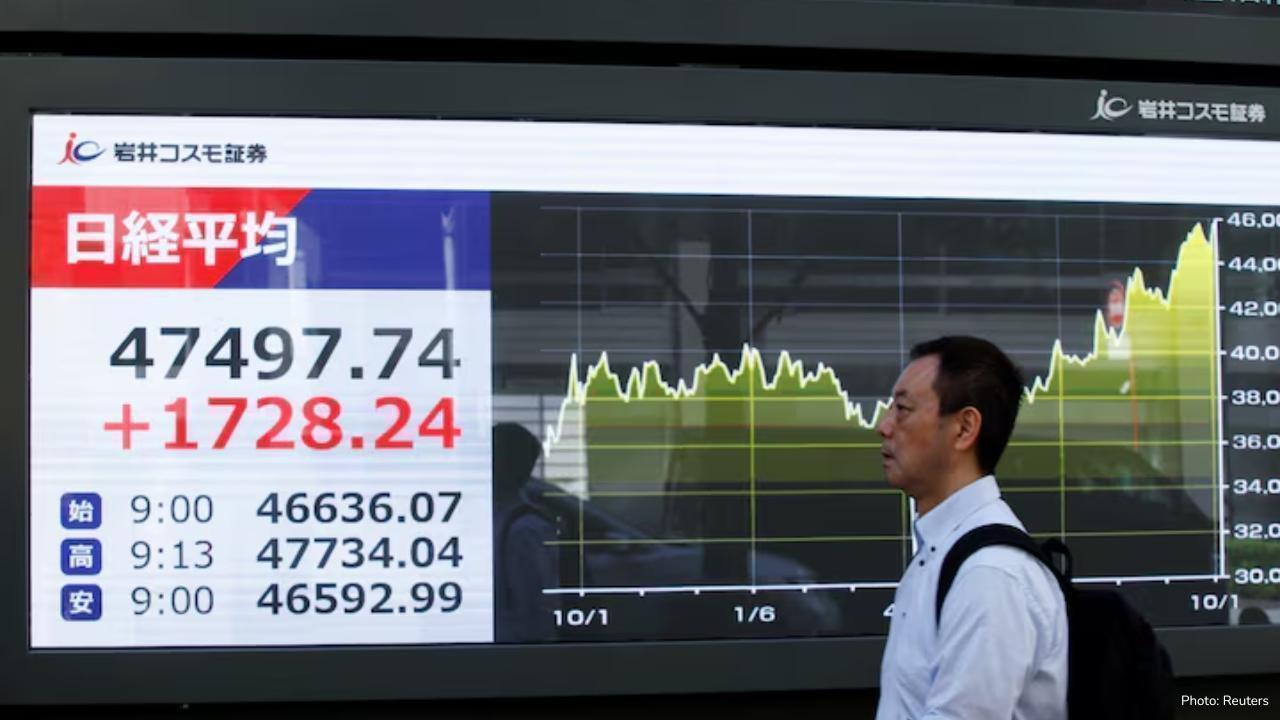
Post by : Monika
On October 6, 2025, financial markets around the world experienced significant movements influenced by political developments, economic data releases, and shifts in investor sentiment. Investors are carefully watching political changes, such as Japan’s recent election results, and economic uncertainty in the United States caused by the ongoing government shutdown. Meanwhile, commodity prices, cryptocurrencies, and bond yields reacted sharply to news from major economies.
Global markets are interconnected. What happens in one country can quickly affect other regions, and today’s market movements show how political events, economic reports, and investor behavior combine to shape global finance.
Political Developments in Japan Shake Markets
Japan experienced a surprising political shift with the election victory of Sanae Takaichi, a right-wing fiscal conservative, positioning her to become the country’s first female prime minister. This unexpected win created optimism in some sectors while raising concerns in others.
The Nikkei index surged to a near-record high of 48,000 points following the election results. Investors welcomed the prospect of potential reforms aimed at stimulating economic growth. However, bond markets reacted differently. Long-term government bond yields rose due to worries over fiscal policies and potential increased government spending. At the same time, short-term yields fell as investors anticipated that the Bank of Japan might delay interest rate increases to support the economy.
The Japanese yen weakened against the euro and the dollar, reflecting uncertainty over Takaichi’s policies. Currency traders were concerned that political pressure on the Bank of Japan could delay rate hikes and affect Japan’s monetary policy. This political change in Japan had ripple effects on Asian markets and influenced global investor sentiment.
U.S. Government Shutdown Adds Uncertainty
Across the Pacific, the United States faced a serious political and economic problem: the ongoing government shutdown. The shutdown was triggered by disputes over federal funding, with President Donald Trump threatening additional funding cuts and potential layoffs of federal workers.
About 750,000 federal employees have been furloughed, costing the U.S. government roughly $400 million daily. Many public services, including processing of economic data and regulatory activities, have slowed or stopped entirely. Investors worry that the government shutdown could delay the release of important economic indicators, such as the September employment report, making it harder to anticipate the Federal Reserve’s next steps regarding interest rates.
The shutdown caused increased market volatility. Stock futures and the U.S. dollar experienced temporary declines, while gold surged to a record high of nearly $3,895 per ounce for three consecutive sessions. Investors are using gold as a safe haven, worried about political uncertainty and potential economic risks.
Asia: Japanese stocks soared on optimism from Takaichi’s election. The Nikkei gained strongly, reflecting investor hope for reforms. China’s Shanghai Composite, however, faced pressure due to economic concerns, such as slowing exports and manufacturing data. Other Asian markets had mixed performance, with South Korea and India seeing moderate gains, while Hong Kong remained largely flat.
Europe: European stock markets were stable to slightly positive. Key indices such as Germany’s DAX and the UK’s FTSE 100 closed higher. Trading volumes were relatively low, partly because of holidays in some Asian countries. Limited economic data from the eurozone, including construction PMI and retail sales, did not create major surprises. Investors were cautious ahead of central bank speeches scheduled later in the week.
United States: U.S. markets were under pressure due to the government shutdown and uncertainty about economic data releases. Major indices, including the S&P 500 and Nasdaq, showed mixed performance. Technology and healthcare sectors contributed positively to gains in certain periods, while energy and industrial stocks faced pressure amid fluctuating oil prices.
In Japan, long-term government bond yields rose due to investor concerns about fiscal policies, while short-term yields fell as traders anticipated delayed interest rate hikes. In the United States, yields on 10-year Treasury bonds were steady, but investor attention remained on Federal Reserve actions and potential interest rate changes.
In Europe, German Bunds and UK Gilts saw minor fluctuations. Investors monitored central bank speeches and upcoming economic data for signs of policy adjustments. Overall, bonds remained a safe investment as markets balanced optimism from stock rallies with caution from political uncertainties.
Gold: Gold prices surged, reflecting investor fears about currency instability, political uncertainty, and potential inflation. Gold reached nearly $4,000 per ounce at one point, making it one of the strongest safe-haven assets during the week. Analysts said that concerns about U.S. politics and Japan’s fiscal uncertainty fueled the gold rally.
Oil: Oil prices declined slightly amid concerns about global supply and demand. Brent crude fell below $90 per barrel, and U.S. West Texas Intermediate (WTI) also dipped. Analysts noted that expectations of increased oil production by major producers and easing supply disruptions contributed to the decline. Investors remained cautious, given the ongoing political risks in major oil-producing regions.
Cryptocurrency Markets
Cryptocurrencies continued to show high volatility. Bitcoin and Ethereum rose sharply, with Bitcoin surpassing $125,000. The surge was partly driven by investor concerns over traditional currencies and the search for alternative stores of value. Cryptocurrencies have increasingly been viewed as a hedge against fiat currency uncertainty, especially amid political instability and government shutdowns.
However, regulatory concerns remained a key factor. Governments in multiple countries are examining cryptocurrency regulation, and new rules could impact prices in the short term. Investors are balancing the potential gains with the risks of market swings and policy changes.
Investor Sentiment
Investor sentiment globally was cautious but mixed. Optimism from Japan’s election and certain economic data releases was tempered by U.S. political uncertainty, economic concerns in China, and the ongoing conflict in Gaza affecting global risk appetite.
Financial analysts emphasized that the current environment requires careful attention to political events, economic reports, and central bank communications. Investors are monitoring short-term volatility while considering long-term trends in global growth and inflation.
Japan: Reports of industrial output and retail sales indicated moderate growth, but investors remained focused on potential fiscal policy changes under the new prime minister.
China: Trade data showed slowing exports, raising concerns about the sustainability of economic recovery. Manufacturing activity in key cities declined, adding pressure on policymakers to implement stimulus measures.
Europe: Limited economic data, including construction PMI and retail sales, were stable but not strong enough to drive significant market moves. Analysts waited for central bank statements to clarify future policy directions.
United States: The delay in September employment data due to the government shutdown added to uncertainty about the Federal Reserve’s next interest rate decisions.
Global Interconnectedness and Risk Factors
The events of October 6, 2025, highlight the interconnectedness of global financial markets. A political change in Japan affects Asian equities and currency markets. Political uncertainty in the United States influences gold prices, stock futures, and investor sentiment worldwide. Economic slowdowns in China impact trade flows and stock markets in Europe and Asia.
October 6, 2025, showed how politics, economic data, and investor behavior drive global market movements. Political changes in Japan, the U.S. government shutdown, economic uncertainty in China, and ongoing geopolitical risks all contributed to volatility in stock, bond, commodity, and cryptocurrency markets.
Gold and bitcoin surged as safe-haven assets, while stock indices experienced mixed results across different regions. Bond yields reflected caution, and oil prices declined amid supply expectations. Investor sentiment remained cautious but opportunistic, with careful monitoring of global developments influencing trading decisions.
The global market landscape remains dynamic, and the events of this day highlight the importance of understanding political, economic, and financial interconnections. Investors, policymakers, and financial institutions must consider multiple factors when assessing risks and opportunities in an increasingly interconnected world.










NBA Friday Recap: Powerhouse Wins for Miami, LA, Milwaukee, and Clippers
Miami, LA Lakers, Milwaukee, and Clippers triumphed in a thrilling NBA Friday, showcasing standout p

Doncic Shines with 49 Points in Lakers' 128-110 Victory over Timberwolves
Luka Doncic dazzles with 49 points as the Lakers secure a 128-110 win against the Timberwolves, show

Kings Triumph Over Jazz 105-104 with Last-Minute Sabonis Effort
The Sacramento Kings edged out the Utah Jazz 105-104, with Domantas Sabonis making the decisive shot

Argentina's Friendly Match Against India Delayed, New Date to be Announced
The friendly match between Argentina and India in Kochi has been postponed due to FIFA approval dela

Rohit and Kohli Conclude ODI Journeys in Australia with a Victory
Rohit Sharma and Virat Kohli bid adieu to Australian ODIs with a final win, forming a 168-run partne

George Russell's Wrestling Mask Antics at Mexican Grand Prix
George Russell donned a wrestling mask to enjoy the Mexican Grand Prix from the stands, providing a